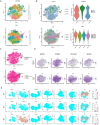Single-cell RNA sequencing identifies the expression of hemoglobin in chondrocyte cell subpopulations in osteoarthritis
- PMID: 39736555
- PMCID: PMC11687149
- DOI: 10.1186/s12860-024-00519-3
Single-cell RNA sequencing identifies the expression of hemoglobin in chondrocyte cell subpopulations in osteoarthritis
Abstract
In recent years, chondrocytes have been found to contain hemoglobin, which might be an alternative strategy for adapting to the hypoxic environment, while the potential mechanisms of that is still unclear. Here, we report the expression characteristics and potential associated pathways of hemoglobin in chondrocytes using single-cell RNA sequencing (scRNA-seq). We downloaded data of normal people and patients with osteoarthritis (OA) from the Gene Expression Omnibus (GEO) database and cells are unbiased clustered based on gene expression pattern. We determined the expression levels of hemoglobin in various chondrocyte subpopulations. Meanwhile, we further explored the difference in the enriched signaling pathways and the cell-cell interaction in chondrocytes of the hemoglobin high-expression and low-expression groups. Specifically, we found that SPP1 was closely associated with the expression of hemoglobin in OA progression. Our findings provide new insights into the distribution characteristics of hemoglobin in chondrocytes and provide potential clues to the underlying role of hemoglobin in OA and the mechanisms related to that, providing potential new ideas for the treatment of OA.
Keywords: Chondrocyte; Hemoglobin; Osteoarthritis; Single-cell sequencing.
© 2024. The Author(s).
Conflict of interest statement
Declarations. Ethics approval and consent to participate: Animal procedures in this study were approved by the Northern Theater General Hospital Animal Medical Research Ethics Committee, and conducted according to the fundamental principles of the Basel Declaration and the ethical guidelines of the International Council for Laboratory Animal Science (ICLAS). Consent for publication: Not applicable. Competing interests: The authors declare no competing interests.
Figures





Similar articles
-
Single-cell RNA sequencing reveals different chondrocyte states in femoral cartilage between osteoarthritis and healthy individuals.Front Immunol. 2024 May 29;15:1407679. doi: 10.3389/fimmu.2024.1407679. eCollection 2024. Front Immunol. 2024. PMID: 38868774 Free PMC article.
-
Single-cell profiling uncovers synovial fibroblast subpopulations associated with chondrocyte injury in osteoarthritis.Front Endocrinol (Lausanne). 2024 Dec 10;15:1479909. doi: 10.3389/fendo.2024.1479909. eCollection 2024. Front Endocrinol (Lausanne). 2024. PMID: 39720254 Free PMC article.
-
Combining bulk and single-cell RNA-sequencing data to reveal gene expression pattern of chondrocytes in the osteoarthritic knee.Bioengineered. 2021 Dec;12(1):997-1007. doi: 10.1080/21655979.2021.1903207. Bioengineered. 2021. PMID: 33749514 Free PMC article.
-
The Role of Chondrocyte Hypertrophy and Senescence in Osteoarthritis Initiation and Progression.Int J Mol Sci. 2020 Mar 29;21(7):2358. doi: 10.3390/ijms21072358. Int J Mol Sci. 2020. PMID: 32235300 Free PMC article. Review.
-
New insights into the mechanisms and therapeutic strategies of chondrocyte autophagy in osteoarthritis.J Mol Med (Berl). 2024 Oct;102(10):1229-1244. doi: 10.1007/s00109-024-02473-1. Epub 2024 Aug 15. J Mol Med (Berl). 2024. PMID: 39145815 Review.
Cited by
-
Integrative analysis of bulk and single-cell RNA sequencing data reveals increased arachidonic acid metabolism in osteoarthritic chondrocytes.Front Med (Lausanne). 2025 May 9;12:1552029. doi: 10.3389/fmed.2025.1552029. eCollection 2025. Front Med (Lausanne). 2025. PMID: 40417665 Free PMC article.
References
-
- Bellelli A, Tame JRH. Hemoglobin allostery and pharmacology. Mol Aspects Med. 2022;84:101037. - PubMed
-
- Maes C, Carmeliet G, Schipani E. Hypoxia-driven pathways in bone development, regeneration and disease. Nat Rev Rheumatol. 2012;8(6):358–66. - PubMed
-
- Gell DA. Structure and function of haemoglobins. Blood Cells Mol Dis. 2018;70:13–42. - PubMed
MeSH terms
Substances
Grants and funding
LinkOut - more resources
Full Text Sources
Medical
Research Materials
Miscellaneous

